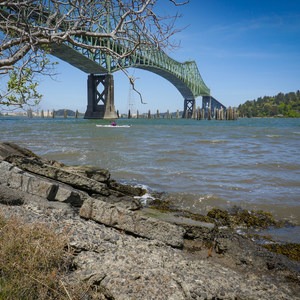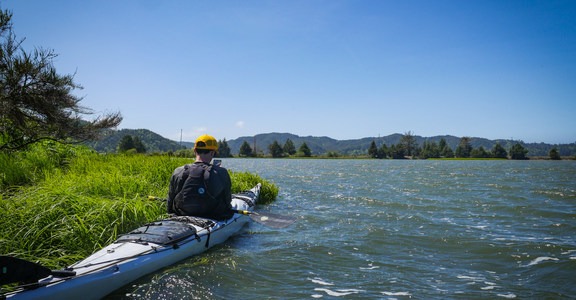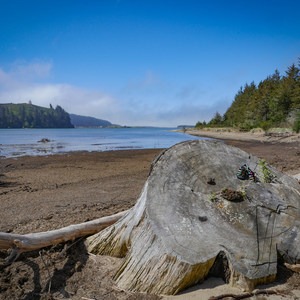On the Oregon coast, bald eagles (Haliaeetus leucocephalus) are a breathtaking sight and quite popular with beachgoers. Researchers are only now beginning to better understand the effects these striking predators have on fragile bird populations like the common murre (Uria aalge).
Once in decline and listed as an endangered species in North America, the bald eagle has staged a remarkable and welcome comeback. According to the U.S. Fish and Wildlife Service, bald eagles nearly went extinct in the United States due to a number of factors: The clearing of virgin forests resulted in habitat loss, excessive hunting of shore birds and ducks jeopardized food sources, and the widespread use of the insecticide DDT devastated the eagle population.
After concerted efforts to ban DDT, prohibit the killing of eagles, improve water quality, and protect nesting sites, bald eagles once again soar across skies and delight viewers with majestic flights and aggressive hunting tactics. The bald eagle population has increased by 7 percent each year between 1978 and 2007 in Oregon alone, which is an extremely successful repopulation rate by any measure. An unforeseen consequence of this robust return, however, is the effect the eagles are having on birds like the common murre, which nest on rocky islands off of the Oregon coast.
The common murre, also known as a thin-billed murre in North America, is a smaller duck-like bird that spends most of its life at sea. Common murres hunt for food below the ocean's surface, and they can dive to depths of 100 meters in a search for prey. They forage in flocks and breed in dense moving colonies of birds that are typically located high on cliff faces for protection. Common murres only access rocky coasts in order to breed, and it is in these unlikely locations that their eggs sit directly on bare rock. The downy chicks typically fledge the nest after around 20 days and can dive for food as soon as they touch down on water. Given the precarious nature of the nesting location, common murre hatchlings are particularly vulnerable to predation from bald eagles.
According to the USFWS and research performed by Oregon State University associate professor Rob Suryan and graduate researcher Cheryl Horton, “a seven-year survey conducted at Yaquina Head found that, from 2007 to 2010, murre reproductive success--their ability to raise chicks to fledging age--ranged between 55 and 80 percent, even with a few eagles present. But by 2011, as both eagle populations and their predatory disturbance increased near the colony, that success dropped to 20 percent--meaning some 80 percent of murre pairs failed to rear young.” Drastic reductions in success can have longer term consequences for a population. Fortunately, the common murre has a long reproductive period of roughly 15 years.
While actual predation is a source of loss, predatory swooping has the most profound impact. With each pass of a bald eagle, frightened murres flee to the water, exposing their eggs and chicks. As bald eagles are not the only predators preying on the colony, birds like gulls, ravens and even pelicans like to attack during the momentary panic. Nesting location adds an additional layer of risk. In a panic, unprepared chicks often race straight off the cliff, falling to their death.
Gulls and crows have been quick to take advantage of the increase in bald eagle attacks on the common murre population. Gulls will alert others of the presence of eagles, increasing the hunting pressure. Even turkey vultures (Cathartes aura) have been seen gorging on common murre nesting sites.
It is unclear whether these interactions are merely a return toward a previously upset balance or a new and more permanent shift in species populations. It is assumed that murres were preyed upon by eagles historically, but specific data is lacking. As bald eagle populations increase, it is likely their influence will be felt on other at-risk species like cormorants and great blue herons. Sadly, the imbalanced relationships between these predators and their prey is largely human caused, and the fix for this imbalance will require still more human intervention. Wildlife managers are faced with increasingly difficult management decisions regarding how (and when) to manipulate populations to achieve restoration goals.
Understanding the complex web of interactions affecting common murre populations poses a puzzle for researchers to attempt to solve. Researchers at OSU are working to better understand changes among common murre and bald eagle populations along the Oregon coast. Since 2007 there has been a slight decline in the overall common murre population size, while the bald eagle population has increased more than tenfold. Work is now being done to analyze historical datasets to better understand the factors affecting delicate shore bird populations. Scientists have much research to do to fully understand these predator-prey relationships.
To learn more, check out the following resources:
- Three Arch Rocks - U.S. Fish and Wildlife Services
- High Country News: The Bald Eagle Paradox
- Common Murre
- Bald Eagle
- Seabird Predators of the Oregon Coast
Featured image by Peter Pearsall/USFWS.
A profound concept originally envisioned by governor Oswald West, in 1967 the Oregon legislature ultimately realized his vision of making the entire Oregon Coast forever open to the public in a piece of landmark legislation titled the Oregon Beach Bill, officially making all 363 miles public land. "The People's Coast" is truly a one-of-a-kind coastline, a unique blend of mountains and rocky stacks, towering old growth forests, marine sanctuaries, tide pools and kelp forests, charming towns, historic fishing communities, world-class golfing, breweries, and simply jaw-dropping scenic beaches. We encourage you to plan your next trip at visittheoregoncoast.com or by calling (541) 574-2679.






Comments
Sign In and share them.